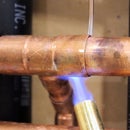Introduction: 5 Old School Plumbing Tricks!
What's up everyone, just another plumbing tricks article and video for you guys, some of these tricks are suggestions from you guys, thank a lot and enjoy.
Step 1: BLACK THREADED STEEL
If you’re not used to working with thread black steel piping, here’s a neat trick that’ll save you time and money when working with ¾” and 1” piping. When taking your measurement, place your tape on the face of the fitting to the center of where your pipe needs to go and that’s your measurement, easy right?
Step 2: SECURE THAT PIPE
If you don’t have the right size pipe clamp, here’s an old school trick that’ll help you secure your pipe temporarily until you get the right clamp. Grab your adjustable wrench, and bend the tail-end of the clip this will make it fit a smaller pipe and will get you out of trouble at no extra cost if you’re stuck.
Step 3: NO MORE CROOKED CUTS
Whenever cutting any type of pipe, they need to be cut straight. If you don’t have a wrap around, here’s a good alternative that’ll give you similar results. Get yourself a hose clamp that fits pipe size and scribe your line to be cut, a straight line guaranteed every time.
Step 4: FITTING-SAVER
There are many ways to salvage a glued fitting as seen in my previous articles, but here’s another cool way to get it done. Get yourself a heat gun, and heat the assembly till it becomes soft enough to insert a pair of needle nose pliers in between the fitting and the pipe. The, grasp the pipe really good and twist it, it should come right out. Use this method in a well-ventilated area.
Step 5: DON'T WASTE THAT DOPE!
And as the last trick, getting to the bottom of your dope cans isn’t always easy, you could cut them in half or simply pound the can till you can reach the bottom with the brush saving you money in the long run.

Participated in the
Fix It! Contest













